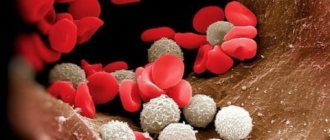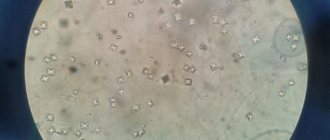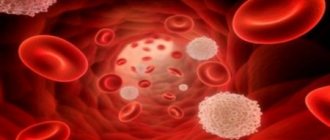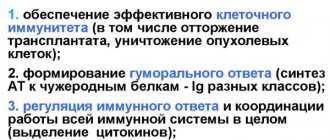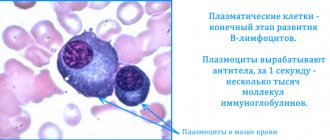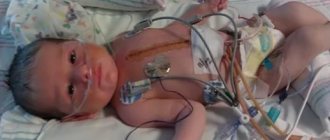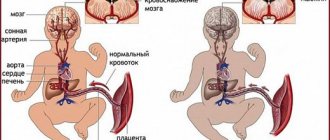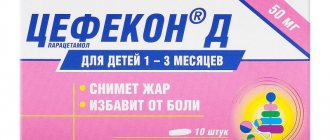What it is?
Segmented neutrophils are one of the types of neutrophils ; they make up the bulk of leukocytes. They are formed from rods - this is their immature form. Mature neutrophils stay in the blood longer than immature ones - about 2-8 hours, and only then penetrate through the vascular walls into the organs. This is due to the fact that there are always more segmented neutrophils in the blood than band neutrophils.
In band neutrophils, the nuclei are smooth, solid and similar to curved rods. In segmented ones, they are divided into segments of 2-5 pieces, which is why they are also called granular. This nuclear structure allows these cells to migrate through the walls of blood vessels into organs and tissues.
Reference! The cytoplasm of neutrophils is pink and the granulation is brown. If there is an inflammatory process in the body, the grain becomes larger and turns blue.
The main function of neutrophils is to fight various infectious pathogens that enter the human body from the outside (primarily fungal and bacterial), as well as maintaining the immune system at the proper level. Neutrophils are produced by the bone marrow and can quickly move and concentrate in areas of tissue damage or inflammation.
When pathogenic flora enters the human body, segmented neutrophils absorb and digest them, while the neutrophils themselves die - this is called phagocytosis or phagocytic activity.
Neutrophils are microphages; they are capable of absorbing only small foreign particles and cells. These structures contain myeloperoxidase, an enzyme that, after cell death, increases the effect of antibacterial agents in human blood. When these biological substances are released in large quantities, they begin to damage bacteria and activate the accumulation of immune cells in the affected area.
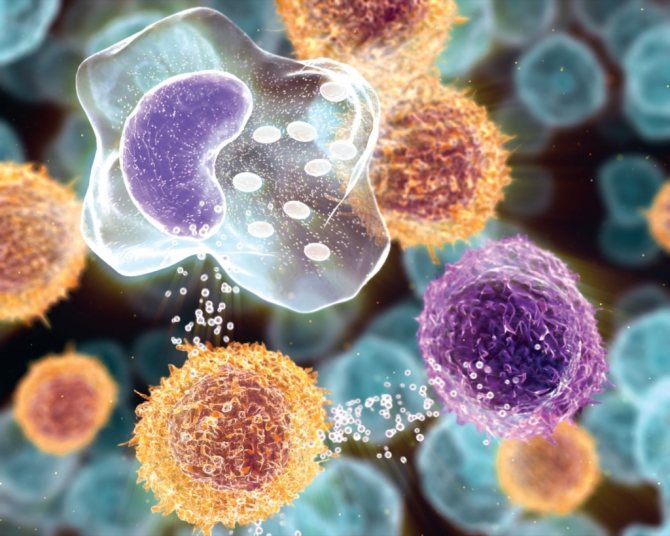
Dead neutrophils, cell mass destroyed by the inflammatory process, and pathogenic microorganisms form a mixture called pus. The pus is green because the enzyme myeloperoxidase has a green pigment.
As for viral infections, neutrophils play a much smaller role in the fight against them, and also practically do not participate in the fight against helminths and tumors.
The segment in the blood is normal in a child
The segment in the blood test is normal.
Segmented neutrophils are the largest group of leukocytes. The blood of a healthy person contains 50-70% of all white blood cells. Granules are present in the cytoplasm, which is why they are called neutrophilic granulocytes or granular leukocytes. They differ from basophils and eosinophils, which also have inclusions in the cell, in their ability to perceive dyes.
Neutrophils are divided into two groups based on the shape of their nucleus. Immature leukocytes - band-nuclear - precursors of segmented leukocytes, are contained in the amount of 1-6% of the total number of white blood cells. The appearance of constrictions in their nuclei means the transition to a mature form.
Functions
Band and segmented neutrophils protect the body from infections, primarily bacterial and fungal. They are able to migrate outside the bloodstream to the source of inflammation, absorb microorganisms, and destroy them with the help of enzymes.
This ability of leukocytes is called phagocytosis, which happens:
When phagocytosis is completed, the microbe is completely digested inside the neutrophil, and its remains are thrown out of the cell. If not completed, the leukocyte dies along with fragments of microorganisms and is excreted in the form of purulent discharge. One segmented neutrophil can digest up to 30 bacteria.
The membranes of segmented neutrophils can easily change their shape, forming protrusions, with the help of which the leukocyte moves to the site of introduction of the microorganism. The neutrophil chooses the direction of movement based on chemicals released by damaged tissues. This method of movement is called chemotaxis.
In addition to phagocytosis, segmented granulocytes perform the following functions:
- bactericidal - release substances that kill bacteria;
- influence the blood coagulation system;
- affect body temperature;
- play an important role in regulating the intensity of inflammation and activation of the immune system.
Norms
The number of neutrophils in a blood test is counted by a laboratory assistant. At least 100 cells must be counted. Automatic analyzers count up to 2,000 neutrophil objects in the blood of a child or adult, but errors occur when determining the shape of the nucleus - the number of segmented and band granulocytes is not accurately counted.
Often there is a need to determine not the relative, percentage, but the absolute number of leukocytes. In a blood test in an adult, the norm for segmented neutrophils is 50-70%, and band neutrophils are 1-6%.
In absolute numbers (designated “abs”), the number of neutrophils per liter of blood is:
- segmented abs. – 2.5 – 5.5x10⁹ ml/l;
- stab abs. – 0.05 – 0.3x10⁹ ml/l.
The number of white blood cells in women is the same as in men. The content of neutrophils in a child is distinguished by the presence of immature forms. Segmented neutrophils in a child under one year of age are reduced. Data on the number of lymphocytes in children are given in the table:
In children under one year old
For children 1-13 years old
Leukocyte formula
A general blood test shows not only the number of neutrophils, but also the ratio of mature forms - segmented and immature - band. The leukogram reflects information in sequence from left to right: first indicate the number of band granulocytes, then segmented granulocytes. Therefore, an increase in the number of young forms of leukocytes is called a shift of the leukocyte formula to the left, and an increase in mature forms is called a shift to the right.
An increase in the number of band-nuclear, immature neutrophils indicates the mobilization of the body's defenses. With severe infection, extreme stress of the immune system, metamyelocytes and promyelocytes appear in the blood. In healthy people, they are found in the bone marrow and are not found in the blood. Their appearance is a signal of alarm and the need for medical attention.
A shift in the leukocyte formula to the left is a consequence of the following pathological conditions:
- acute inflammation;
- purulent infections;
- large blood loss;
- exogenous poisoning.
A shift in the leukocyte formula to the right is an increase in mature segmented neutrophils. Evidence of inhibition of leukopoiesis is the formation of young forms of leukocytes, a decrease in the reproductive function of the bone marrow.
- severe diseases of internal organs that last a long time with severe intoxication;
- renal, liver failure;
- aplastic anemia;
- malignant tumors;
- radiation sickness;
- chemotherapy of oncological diseases.
A shift in the leukocyte formula to the left or right appears in the early stages of diseases. An alarming signal is the tension of the body’s defenses in the fight against severe pathology. Its early diagnosis is an important condition for effective, timely treatment.
Changes in the numerical composition of segmented neutrophils
When studying the results of a general blood test, the number of leukocytes is taken into account. An increase in the number of segmented neutrophils above 75% is neutrophilia, low numbers are neutropenia. Such values are an important diagnostic sign. An increase in the number of leukocytes can be a physiological phenomenon - during pregnancy, after physical activity.
In the absence of a shift in the leukocyte formula, neutrophilia is accompanied by an increase in segmented and band neutrophils.
- bacterial, purulent processes;
- inflammatory diseases of internal organs;
- the presence of extensive foci of necrosis during gangrene, heart attacks, trophic ulcers;
- kidney pathology in diabetes;
- tumors.
Neutrophilia can be a consequence of vaccination, treatment with hormones, and anticoagulants.
A decrease in segmented neutrophils in the blood occurs in the following diseases:
- bacterial infections - tuberculosis, paratyphoid fever;
- viral diseases - hepatitis B and C, influenza, scarlet fever, measles;
- rickettsioses - toxoplasmosis, malaria;
- agranulocytosis;
- side effects of analgesics, some antibiotics;
- hypoplastic anemia;
- ionizing radiation.
Neutrophilia and neutrophils below normal are a consequence of pathological processes, and therefore require a thorough examination. The severity of the disease can be judged by the degree of change in the quantitative composition of leukocytes. Therapy for segmented neutrophilia and neutropenia should be carried out after clarifying the cause and diagnosing the underlying disease.
A change in the numerical composition of leukocytes in the pathology of internal organs, an increase or decrease in their number, is a symptom and an important diagnostic sign that does not require special treatment. The exception is bone marrow pathology - leukemia, hematoblastosis, examination and treatment of which is carried out in specialized oncological institutions.
Neutrophils are a type of white blood cell. These are plasma cells, thanks to which the human body fights fungal and bacterial diseases. There are early and mature neutrophils. The latter are called segmented neutrophils.
How are they formed?
After the neutrophil has formed in the red bone marrow, it matures into a stab cell. It penetrates the plasma in a specific amount. After some time, it is divided into certain segments. Thus, it becomes a full-fledged segmented neutrophil, which after 2–5 hours is sent to the walls of the capillaries of various organs. This is where it fights various infections and bacteria.
When is research necessary?
If the doctor has even the slightest suspicion of the presence of an inflammatory process, he will refer the patient for a blood test. Most often, indications for diagnostics are:
- angina;
- pneumonia;
- sepsis;
- appendicitis;
- peritonitis;
- thermal injuries;
- gangrene;
- rheumatic attacks;
- heart attack;
- tuberculosis;
- bleeding;
- chemical poisoning.
Normal indicators
The norm of segmented neutrophils is indicated as a percentage. They are included in the leukocyte formula. Thanks to it, you can assess the condition of the blood and the body as a whole. But first it is necessary to indicate what the norm of the elements presented in the blood is.
If we are talking about a healthy adult, then for him the norm of segmented neutrophils will be 47–72%, and the norm of band neutrophils will be 1–5%.
Children have some differences in the leukocyte formula. After birth, a child experiences a sharp increase in the number of lymphocytes, and the content of neutrophils is low. On the third or fourth day, the child experiences the first crossover, that is, a comparison of cells occurs. Therefore, the rate of band and segmented neutrophils is the same and amounts to 45%.
Decreased segmented neutrophils
When, during the analysis, it was determined that segmented neutrophils are reduced, this indicates the following pathologies in children and adults:
- viral and inflammatory diseases;
- anemia;
- damage by radioactive rays;
- chemical poisoning.
Also, the number of blood elements present in children and adults may be reduced due to poor ecology and prolonged use of medications. These are Analgin, Penicillin. Neutropenia can be congenital or acquired.
If segmental neutrophils are reduced, then chickenpox, influenza and hepatitis may be indications for analysis in a child or adult.
Increased segmented neutrophils
If segmented neutrophils are elevated in a child and an adult, then this is a clear sign of the fight against viruses and bacteria. But each of them has its own specifics. For this reason, specialists send children and adults for additional examination. This way it is possible to determine the reason for such a change. If neutrophils in children and adults are elevated, this indicates the following pathologies:
Blood is always in a mobile state. Therefore, even in a healthy child or adult, segmented neutrophils can be elevated. This is often a manifestation of stress, emotional and physical stress. But when the test is repeated in children and adults, these indicators return to normal.
If, in the absence of a specific disease, a deviation from the norm of segmented neutrophils is detected in a child or adult, do not immediately panic. Such results cannot 100% indicate the presence of pathology. The doctor will prescribe a repeat blood donation. If the result is the same, then the specialist’s actions will be aimed at eliminating the cause that provoked the deviation from the norm in the child or adult.
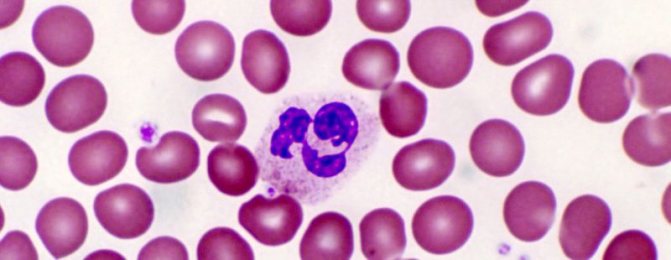
All formed elements of blood are divided into red and white blood cells. Segmented neutrophils are classified as white blood cells or leukocytes.
Neutrophils, according to the degree of maturation, are divided into myelocytes, band and segmented neutrophils.
They also differ in their appearance and practical functions. All shapeless cells that do not have a nucleus visible under a microscope and serve as a transitional model are called myelocytes. The next stage of maturation is represented by band neutrophils. They owe their name to their peculiar shape in the form of the letter S. With a relatively small number (about 1% of all leukocytes), this group of cells bears a fairly large load to protect the body from external aggression. The largest fraction of white blood cells are segmented neutrophils. Their number ranges from 40 to 80% of all leukocytes in the blood plasma. The process of their maturation is almost complete, as evidenced by the presence of a dense nucleus in the cell.
Almost the entire phagocytic function of blood plasma lies with segmented neutrophils. The place of their permanent dislocation is the bone marrow, from where the cells are released into the vascular bed when a threat to the health of the individual arises. For this reason, to monitor the level of segmented neutrophils in various pathologies, not only general and detailed blood tests are performed, but also a puncture of bone marrow tissue is examined.
When pathogens of various infectious, microbial or viral diseases penetrate the human body, as well as in the presence of foci of necrosis in the tissues, the protective function of these cells manifests itself. Since segmented neutrophils have the ability to destroy various harmful particles (entered into the blood and tissues of the patient), as well as neutralize their pathogenic effect on the body, their work forms the basis of the human immune system.
In the medical community, this phenomenon is called phagocytosis.
It has been noted that when conducting laboratory tests during the height of inflammation, there is always a drop in the percentage of neutrophils in the blood plasma. During the recovery of the body, their number gradually normalizes.
Norm of segmented neutrophils in adults and children
It should be understood that the human immune system undergoes significant changes throughout life. Since the level of neutrophils in plasma interacts with this protective system, it also changes with a person’s age. Changes in the percentage of segmented neutrophils in different age groups can be given:
- from birth to 1 year of life – 10–40%;
- age from one to 6 years – 20–45%;
- teenagers 8–14 years old – 30–60%;
- youth 16–20 years old – 35–65%;
- men 25–60 years old – 50–80%;
- women 25–55 years old – 40–70%.
If decoding tests requires absolute numbers, then the norm varies depending on the patient’s age from 1.5 to 8.2 g/l.
During laboratory examination, sometimes only the percentage of neutrophils to leukocytes is determined. In this case, it is recommended to perform simple arithmetic calculations to establish the absolute indicator - multiply the leukocyte content in the plasma and the relative indicator of segmented neutrophils.
Norm and pathology of segmented neutrophils in children
A child’s leukocyte count is an important indicator of the correct and stable functioning of his immune system. The quantitative indicators and percentage of all forms of leukocytes, including segmented neutrophils, depend on the age of the baby.
Changes in segmented neutrophils with age
| Child's age | Number of neutrophils per 1 liter. | Segmented neutrophils |
| 0–3 months | 1.5–8 billion | 45–80% |
| 3–12 months | 1.8–8.5 billion | 15–45% |
| 1–14 years | 2–6 billion | 35–62% |
The excess of all forms of neutrophils above the specified normal indicators indicates a possible serious pathology in the child’s body. However, in children, as in adults, abnormal levels of segmented neutrophils are not always associated with disease. Taking large doses of analgesics, hormones, and barbiturates can lead to low levels of neutrophils in the blood plasma. Sometimes hereditary disorders are also observed.
Indicators of the content of segmented neutrophils in the blood plasma do not allow the doctor to make a final diagnosis, since their changes are characteristic of various diseases. Additional examination methods are required to accurately diagnose possible pathology. However, normal numbers for the presence of segmented neutrophils in the blood plasma indicate good functioning of the immune system and the complete health of the patient being tested.
Post Views: 22
Norm
In the blood of an adult and a child over 13 years of age, all types of leukocytes should be 4-10 * 10 to the 9th degree / l of blood, of which neutrophils - 48-80%. Of these, the initial form of neutrophils is 1-3%, band neutrophils 1-6%, segmented - 45-72%.
In children under 12 years of age, the immune system is developing, so their leukogram is somewhat different. Babies are born with an “adult” norm of segmented neutrophils , which continues to increase in the first day of the child’s life, and then sharply decreases.
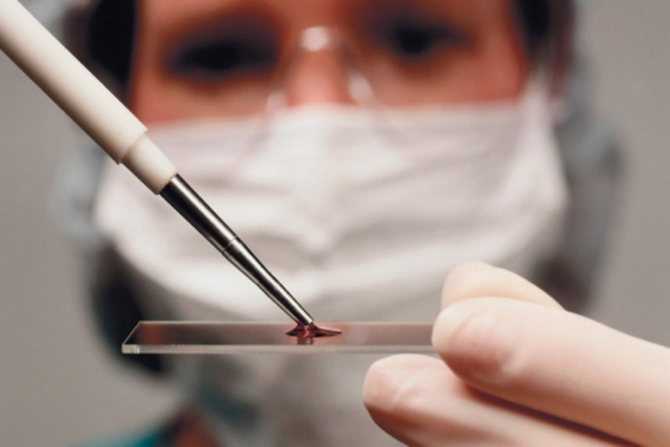
At 5-7 years, the number of segmented neutrophils increases again, and during this period, pediatricians and parents note that the child begins to suffer from colds less often.
Age norms of segmented neutrophils in the blood of children:
- first day – 50-70%;
- 1-5 days – 35-55%;
- 5-15 days – 25-45%;
- 15-30 days – 15-30%;
- 1-12 months – 20-35%;
- 1-6 years – 35-55%;
- 7-10 years – 40-60%;
- 11-15 years 40-75%.
Indicators increased
When the level of neutrophil cells increases, it is called neutrophilia. However, a slight increase can be observed with excessive physical or psycho-emotional stress, as well as after eating. If the reason for the increase in neutrophils is related to the disease, then their level will directly depend on the activity of the disease.
Reasons for the increase
Pathological reasons for increased neutrophil levels include:
- active inflammatory processes - dermatitis, pneumonia, appendicitis, inflammatory process in the pancreas, and so on;
- the presence of a bacterial infection in the body, including purulent lesions - phlegmon, abscess,
- some infections of viral origin;
- fungal infection or infections caused by protozoan microorganisms;
- tumor processes;
- burns;
- diabetes;
- poisoning;
- trophic ulcer;
- taking certain medications, such as corticosteroids;
- hemolysis of red blood cells or acute blood loss.
Neutrophils increase in the postoperative period.

It should be noted that doctors evaluate the fact due to which cell forms the increase occurred:
- Shift of the formula to the left - increased band neutrophils - this often happens with leukemia, anemia, purulent infections and burns.
- A shift of the formula to the right —segmented neutrophils are increased—occurs in leukemia, anemia, and polycythemia.
Symptoms
Most often, an increase in neutrophils in the blood begins without any symptoms, this is due to the fact that the rods appear at the onset of the disease, and it takes time for them to mature.
Deviations
The segments in children's blood may change as they grow older. Their absolute and relative values make it possible to assess the state of health.
Increasing values
A temporary and slight increase in the level of neutrophil granulocytes is allowed against the background of physical activity and negative emotions, while the concentration of other blood cells should not be subject to changes. If a prolonged increase in the level of neutrophils and leukocytes (neutrophilia) is detected, the child must be further examined.
Neutrophilia can occur when:
- leukemia;
- hemolytic anemia;
- acute inflammatory diseases;
- tissue necrosis due to burns, tropical ulcers;
- diabetes mellitus
If only segmented neutrophils increase, then the following may develop:
- acute inflammatory process;
- infections without specific symptoms;
- benign or malignant tumor.
If there is a sharp and significant jump in the level of neutrophils, the child must be urgently examined and treated.
Downgrade
When the functions of the immune system are weakened, the concentration of neutrophils decreases (neutropenia). In a child's body, cells work hard and are destroyed, divided in insufficient quantities or distributed incorrectly.
Important information: What is WBC in a child’s blood test (table of interpretation and norms)
Causes of neutropenia;
- dysfunction of the bone marrow;
- recent illness;
- viral diseases (rubella, ARVI, measles);
- anemia;
- thyrotoxicosis (thyroid dysfunction);
- fungal diseases;
- exposure to chemicals;
- taking painkillers.
In the first year of life, children may develop chronic benign neutropenia. It is not uncommon for this condition to last for several years. In this case, the child does not have any health problems, and the characteristic clinical picture does not appear. The disease does not require treatment and goes away on its own.
Reduced values
A decreased neutrophil count is called neutropenia . There are:
- hereditary neutropenia;
- congenital;
- acquired.
Hereditary forms are passed on from generation to generation, and may have absolutely no effect on the child’s condition; they are considered an individual characteristic of the body.
Congenital pathologies of the immune system, as well as other disorders, contribute to the progress of neutropenia, and this naturally affects the functioning of the child’s entire body.
The mechanism for the decrease in segmented neutrophils may be as follows:
- Decreased production or disruption is the result of a malfunction of the bone marrow.
- Redistribution - segmented neutrophils cluster and move to the site of inflammation.
- Increased percentage of death and elimination - cells die or the body itself destroys low-quality pathological forms.
When the leukocyte formula shifts to the left, the number of segmented neutrophils decreases in favor of young forms - metamyelocytes, stabs and myelocytes.
Important! Changing the formula may be a natural response to exposure to a pathogenic factor; in all other cases, immediate medical intervention and identification of the causes are required.
In a newborn child, the norm of segmented neutrophils is the same as in an adult , and if the deviation occurs in the direction of decrease, parents should be wary of hereditary and congenital forms of pathology.
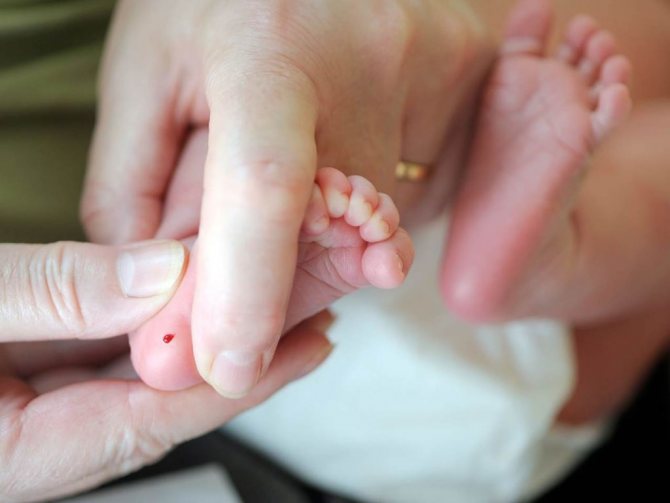
It could be:
- infantile agranulocytosis;
- cyclic congenital neutropenia;
- benign familial neutropenia.
Breastfed babies are well protected from infections , since a large number of immune cells enter their bodies with breast milk, which fight viruses and bacteria. Children who are bottle-fed are at risk for various pathologies.
When neutrophils are reduced to a year, neutropenia may be accompanied by the appearance of binuclear pathological segmented neutrophils.
You should be extremely careful when prescribing medications to children under 2 years of age, as in some cases this can cause agranulocytosis. This is especially true for drugs of the sulfonamide group and non-steroidal anti-inflammatory drugs.
How to determine the level
Neutrophils in a child can be examined in the following ways:
- clinical blood test;
- blood chemistry;
- bone marrow biopsy.
General blood analysis
The quantitative composition of neutrophils can be determined using a complete blood count (CBC), because these white blood cells quickly respond to changes in the body.
In order for the research result to be accurate, the following rules must be followed:
- take the test on an empty stomach;
- for several days before taking the OAC, do not eat spicy and fried foods, as well as foods with preservatives and food additives;
- if possible, do not take medications;
- avoid intense muscle activity;
- ensure a stable emotional state;
- avoid sudden changes in temperature.
During the OAC test, there should be no wounds, scratches, cuts or other damage to the skin. If the child has been vaccinated, then the OAC can be taken after 1-4 weeks.
Blood chemistry
If neutrophils in the blood of children differ greatly from the norm in the direction of increase (neutrophilia, shift of the leukocyte formula to the left), and such a deviation persists for a long time, then additional research should be carried out. A biochemical blood test (BAC) allows you to clarify and expand the information.
Important information: What do decreased segmented neutrophils and increased lymphocytes in a child’s blood indicate?
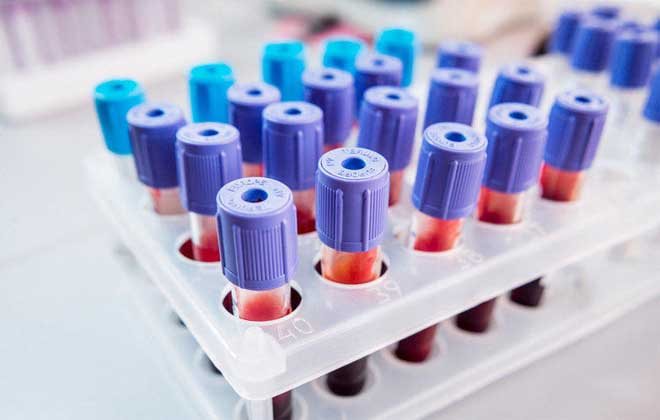
Blood is drawn from a vein. The rules for preparing for the test are the same as for the OAC.
Bone marrow biopsy
The study is carried out if a strong and stable deviation from acceptable indicators is detected. The indication for analysis is a condition in which the norm of young cells is exceeded by 5% against the background of the absence of a history of the following factors:
- intoxication;
- chronic infectious disease;
- irradiation;
- blood loss;
- chronic stress;
- taking specific medications.
If the norm of neutrophils in children is exceeded by more than 10%, this may indicate the development of blood cancer. At concentrations below normal levels, chromosomal disturbances in the synthesis of blood cells are possible.
The biopsy is performed in an outpatient clinic or hospital using local anesthesia.
If the baby is 1 year or younger, then the biomaterial is taken from the femur, tibia or calcaneus. In older children - from the pelvic bone.
